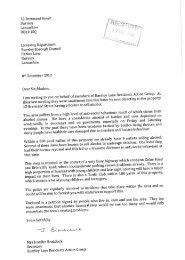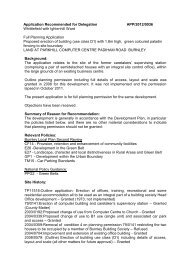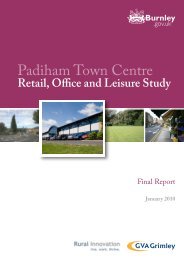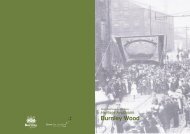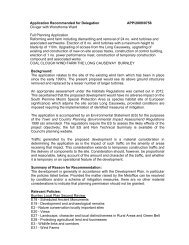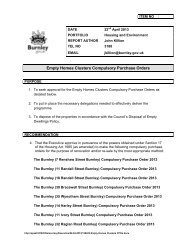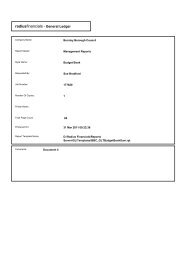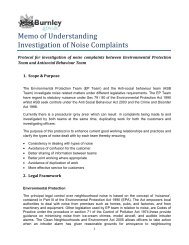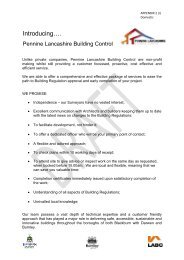The Padiham Heritage Appraisal - Burnley Borough Council
The Padiham Heritage Appraisal - Burnley Borough Council
The Padiham Heritage Appraisal - Burnley Borough Council
- No tags were found...
Create successful ePaper yourself
Turn your PDF publications into a flip-book with our unique Google optimized e-Paper software.
Riverside Mill5.3.16 William Ingham and Sons of Albert Mill erectedRiverside in 1888. <strong>The</strong> mill finally ceased textile productionin the 1990s and today its buildings are used by a number ofnon-textile companies. <strong>The</strong> buildings situated along FleetwoodRoad would have once been the weaving preparation,warehousing and power departments (Rothwell, 2005, p 21-22).This view of the perimeter wall of Riverside mill formspart of the continuous boundary wall around theindustrial area.Gothic Works5.3.17 In addition to the mid 19th century mill buildings andsheds are the later 20th century developments, which arealso located on Wyre Street. Although these modern industrialdevelopments have been constructed from different materials,their scale, massing and employment uses are essentially thesame as the older remaining mills and sheds in the area.5.3.18 <strong>The</strong> site of Gothic works occupies about 8 acres of land north of the River Calder.Glover and Main Ltd established the Works in 1955. Initially the building comprised a singlestorey factory built on the site of <strong>Padiham</strong>’s former football ground (Plans C&D). During themid 1960s the plant produced white goods such as washing machines, boilers and spin dryers.By 1992 Gothic was in the ownership of Baxi, manufacturers of oil and gas boilers, and iscurrently part of the Baxi-Potterton Group (Rothwell, 2005, p.29). <strong>The</strong> main building is a singlestorey factory, although it has a multi-storey office block elevation on to Wyre Street. <strong>The</strong>re areadditional buildings on the site and all appear to have been constructed from a steel frame withsteel clad walls and corrugated roofs.Industry and Enterprise Mills5.3.19 Industry Mill was built by Wilkinson, Bibby and Monk in1851. Hargreaves of Clay Bank Mill (see 3.3.1) opened the adjacentEnterprise Shed slightly later in 1853. A succession of ownersand tenants occupied the buildings well into the second half of thetwentieth century (Rothwell, 2005, pp. 9 &10). Today a van hirecompany uses the shed and the exterior of the buildings appearmuch altered incorporating a modern warehouse with a corrugatedmetal elevation to Wyre Street.Commercial Mill5.3.20 <strong>The</strong> original Commercial Mill building was constructedin 1851 as the first of two co-operative weaving mills in <strong>Padiham</strong>.<strong>The</strong> <strong>Padiham</strong> Commercial Company opened the mill and althoughit received initial support from many local cotton workers, itunfortunately was not a successful venture. A succession ofcompanies operated from the mill during the remainder of the 19thcentury. This period also saw the construction of a second weavingshed adjoining the original mill in 1862 and a further addition tothe mill in 1881. <strong>The</strong> buildings were cleared by the 1980s when K.Raymakers and Sons Limited of Alma Mill constructed a modernbrick built warehouse on the site (see 5.3.13 & Rothwell, 2005, p.9).<strong>The</strong> original weaving shed walls are thought to beretained within the modern warehouse unit. At the rearof the shed is the base of a circular stone chimney.Site of former Commercial Mill, Wyre Street.heritage appraisal 45



